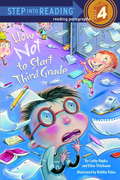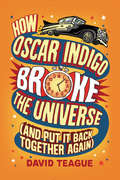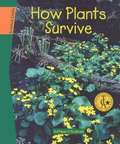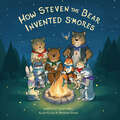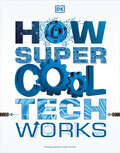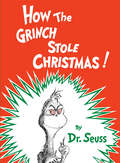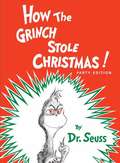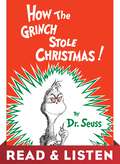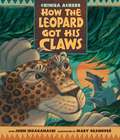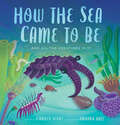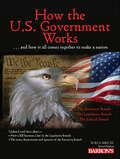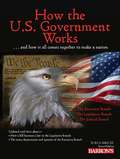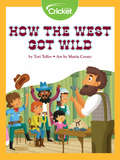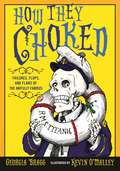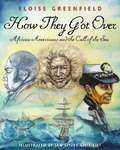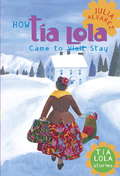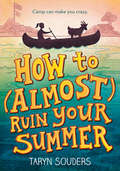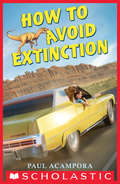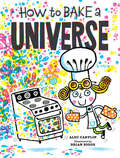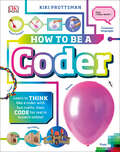- Table View
- List View
How Not to Start Third Grade (Step into Reading)
by Cathy Hapka Debbie Palen Ellen TitlebaumWill should be excited to start third grade. But his little brother, Steve, is starting kindergarten. The same laugh-out-loud writing and hilarious illustrations that brought us How Not to Babysit Your Brother now portray the tribulations and embarrassments of starting school with a very troublesome little brother. School will never be the same!Cathy Hapka and Ellen Titlebaum are the authors of many books for children. This is their second book about Will and Steve. They live in Lincoln University, Pennsylvania, and New York City, respectively.Debbie Palen has illustrated many books for children, including How Not to Babysit Your Brother and the first four books in the Andrew Lost series. She lives in Cleveland, Ohio.
How Oscar Indigo Broke the Universe (And Put It Back Together Again)
by David Teague★ "Suspend all disbelief and enjoy." —Kirkus (starred review)From David Teague, the coauthor of the critically acclaimed Saving Lucas Biggs, comes a funny and sweet story about learning to have courage even when it feels like the world is ending.Oscar Indigo has never been good at baseball, so naturally he’s nervous when he has to fill in for his team’s injured All-Star, Lourdes. Luckily, Oscar has a mysterious gold watch that can stop time, which he uses to fake a game-winning home run. Now Oscar’s the underdog hero of his town and even Lourdes wants to be his friend. But the universe is a precarious place, and you can’t just steal time without any consequences. If Oscar doesn’t find a way to return the time he stole, the universe will unwind completely. Oscar wants nothing more than to ask Lourdes for help, but what would a baseball star like her think of a guy whose fake home run actually destroyed the universe? But as he and Lourdes grow closer, Oscar understands that it isn’t always what you do that makes you special—but who you are. And that confidence just might be the key to fixing the universe.
How Plants Survive (Science Links)
by Kathleen V. KudlinskiPlants compete with one another for sunshine and water, and they struggle to protect their own patch of soil. Find out how plants wage a constant battle for survival.
How Steven the Bear Invented S'mores (Steven the Bear)
by Scott HallHow Steven the Bear Invented S’mores is a read aloud picture book with fun life lessons and colorful illustrations. Steven the Bear and his friends are excited to go on their very first camping adventure. After being sure to pack and prepare well, the Bear Bunch heads out to find the perfect campsite. They set up camp and spend their day hiking, bird watching, and finding animals. After a day full of fun, Steven and the Bear Bunch sit down to toast marshmallows. That’s when Steven has a brilliant idea…? Join Steven the Bear and his friends in this first of many adventures!
How Super Cool Tech Works
by DKDiscover the mind-blowing high-tech inventions of the future! Incredible images reveal the secret inner workings of everything from drones and supercomputers to underwater hotels and flying cars.How Super Cool Tech Works explains how incredible technologies will shape the world of tomorrow. Explore robotics, space rockets, artificial intelligence, and even game consoles in this cutting-edge non-fiction science book for kids aged 9 and over. Also featured are state-of-the-art buildings, new ways of traveling, imaginative entertainment gadgets, and even how teleportation and invisibility cloaks might be possible in the future. Each exciting subject is explained in detail, via crisp images and engaging, child-friendly text. "How it works" panels explain each subject&’s secret inner workings.New and updated for 2020, How Super Cool Tech Works is a one-stop shop for kids who want to know what the latest and greatest technologies are, and how they will shape our world in the years to come.
How Sustainable?: Science 4. 6 (Panorama)
by Catherine Fox Beth Geiger Judy ElginNIMAC-sourced textbook
How the Earth Works: 60 Fun Activities for Exploring Volcanoes, Fossils, Earthquakes, and More
by Michelle O'Brien-PalmerEarth science comes alive for children 6 to 9 through 60 engrossing games, activities, and experiments. Kids “core sample” a filled cupcake and discover plate tectonics by floating graham cracker continents on a molten mantle of molasses. They learn how heat changes rocks by seeing how separate ingredients disappear when they bake Rice Krispie Treats. More activities show what causes earthquakes and what kinds of buildings resist their force. Growing sugar and salt crystals, “fossilizing” plastic insects, and modeling a variety of volcanoes add to the learning and the fun. Eight of the activities are tasty as well as informative. Silly songs help children remember new words and concepts, and a resource section gives inexpensive sources for rocks, minerals, and fossils. All the projects have been tested in homes and schools to make sure they are safe, effective, and fun.
How the Grinch Stole Christmas (Classic Seuss)
by Dr. SeussGrow your heart three sizes and get in on all of the Grinch-mas cheer with this Christmas classic--the ultimate Dr. Seuss holiday book that no collection is complete without! Every Who down in Who-ville liked Christmas a lot . . . but the Grinch, who lived just north of Who-ville, did NOT! Not since "'Twas the night before Christmas" has the beginning of a Christmas tale been so instantly recognizable. This heartwarming story about the effects of the Christmas spirit will grow even the coldest and smallest of hearts. Like mistletoe, candy canes, and caroling, the Grinch is a mainstay of the holidays, and his story is the perfect gift for readers young and old. "Irrepressible and irresistible." --Kirkus Reviews
How the Grinch Stole Christmas
by Dr Seuss"Every Who down in Who-ville liked Christmas a lot... but the Grinch, who lived just north of Who-ville, did NOT!" Not since "'Twas the night before Christmas" has the beginning of a Christmas tale been so instantly recognizable. No holiday season is complete without the Grinch, Max, Cindy-Lou, and all the residents of Who-ville, in this heartwarming story about the effects of the Christmas spirit on even the smallest and coldest of hearts. Like mistletoe, candy canes, and caroling, the Grinch is a mainstay of the holidays, and his story is the perfect gift for young and old. Images and image descriptions available.
How the Grinch Stole Christmas!
by Dr Seuss<p>“Every Who down in Who-ville liked Christmas a lot . . . but the Grinch, who lived just north of Who-ville, did NOT!” Not since “’Twas the night before Christmas” has the beginning of a Christmas tale been so instantly recognizable. This heartwarming story about the effects of the Christmas spirit will grow even the coldest and smallest of hearts. Like mistletoe, candy canes, and caroling, the Grinch is a mainstay of the holidays, and his story is the perfect gift for young and old. <p>And don't forget to celebrate Grinch-mas this Christmas season, the annual holiday tradition inspired by How the Grinch Stole Christmas that encourages readers to grow their hearts three sizes by doing good deeds!</p>
How the Grinch Stole Christmas! Read & Listen Edition (Classic Seuss)
by Dr. Seuss&“Every Who down in Who-ville liked Christmas a lot . . . but the Grinch, who lived just north of Who-ville, did NOT!&” Not since &“&’Twas the night before Christmas&” has the beginning of a Christmas tale been so instantly recognizable. No holiday season is complete without the Grinch, Max, Cindy-Lou, and all the residents of Who-ville, in this heartwarming story about the effects of the Christmas spirit on even the smallest and coldest of hearts. Like mistletoe, candy canes, and caroling, the Grinch is a mainstay of the holidays, and his story is the perfect gift for young and old. This Read & Listen edition contains audio narration.
How the Leopard got his Claws
by Chinua AchebeIn the beginning, all the animals lived as friends. Their king, the leopard, was strong but gentle and wise. Only Dog had sharp teeth, and only he scoffed at the other animals’ plan to build a common shelter for resting out of the rain. But when Dog is flooded out of his own cave, he attacks the leopard and takes over as king. And it is then, after visiting the blacksmith’s forge and knocking on Thunder’s door, that the angry leopard returns to regain his throne by the menace of his own threatening new claws. In a riveting fable for young readers about the potency and dangers of power taken by force, Nigerian writer Chinua Achebe, author of Things Fall Apart, evokes themes of liberation and justice that echo his seminal novels about post-colonial Africa.
How the Sea Came to Be: (And All the Creatures In It)
by Jennifer BerneA lyrical, spectacular history of the ocean—from its dramatic evolutionary past to its marvelously biodiverse present.&“For millions of years these first bits of lifeBecame more, and then more, and then more.&”Long, long ago, when the Earth was young and new, the world was a fiery place. Volcanoes exploded from deep down below, and steamy, hot clouds rose up high. Rain poured down for thousands of years, filling the world&’s very first oceans. There the teeniest stirrings of life began. Earth&’s creatures grew bigger and bigger, evolving into exciting forms like jellyfish, coral, and worms. Millions of years passed. Down in the depths and up on the surface, ocean life grew and spread. Now the sea teems with all kinds of animals—squid, turtles, dolphins, barracudas, even glowing fish, all living in the waters where long, long ago, life itself came to be. Spanning 4.5 billion years of evolution, this extensively researched book is an accessible introduction to geology, oceanography, and marine biology. Entrancing verse, awe-inspiring art, and fascinating back matter capture the mysterious beauty of the ocean and the incredible organisms who call it home.
How the Sphinx Got to the Museum (How The ... Got To The Museum)
by Jessie HartlandDepicts how the Sphinx was commissioned by the Pharaoh, was built, was rediscovered after centuries and then travelled to New York.
How the U.S. Government Works: ...and how it all comes together to make a nation
by Syl Sobel J.D.This updated, easy-to-read book about the United States for kids explains the federal system as it works today. It also discusses why the framers of the Constitution created the U.S. government in the 18th century and the purposes it was designed to serve.Parents, teachers, and gift givers will find:an easy-to-read book about a complex subject revised for the classroom and homecurriculum aligned vocabulary, expanded glossary, discussion questions, and resource guideinformation on how presidents and other officials are elected or appointedDescribed are the Legislative branch, composed of the Senate and the House of Representatives; the Executive branch, headed by the President with the Cabinet members; and the Judicial branch, comprised of the Supreme Court of the United States and the lower federal courts throughout the nation.
How the U. S. Government Works
by Syl SobelA fine classroom supplement and a solid information source for kids writing social studies reports, this updated, easy-to-read book explains the federal system as it works in the United States today. It also discusses some ways in which the government has changed since the framers of the Constitution brought it into existence in the 18th century. Described are the Legislative body, composed of Senate and House of Representatives, the Executive branch, headed by the President with the Cabinet members, and the Judicial branch, headed by the Supreme Court of the United States, and extending to federal courts throughout the nation. New in this edition are facts about how a bill becomes a law, the various departments in the Executive branch, and more. Young readers learn how officials are elected or appointed and how government agencies work for the people's benefit. A complex process is explained in interesting terms that young readers can comprehend.
How the West Got Wild
by Tori TelferChummy and Sandra Bee were the rowdiest little kids in Ruby, Arizona. But when they helped start the gold rush in Ruby, people stopped calling them "wild" and "rambunctious" and started calling them "plucky" and "clever."
How They Choked: Failures, Flops, And Flaws Of The Awfully Famous
by Georgia BraggEveryone makes mistakes. Sometimes, epic failures even lead to super successes . . . sometimes they become deep dark secrets. But remember--to fail is human, to laugh about our shortcomings divine. From Montezuma II's mistaking a conqueror for a god to Isaac Newton turning from science to alchemy to J. Bruce Ismay's jumping the lifeboat line on theTitanic, How They Choked knocks fourteen famous achievers off their pedestals to reveal the human side of history. Successful “failures” include: Marco Polo, Queen Isabella of Spain, Montezuma II, Ferdinand Magellan, Anne Boleyn, Isaac Newton, Benedict Arnold, Susan B. Anthony, George Armstrong Custer, Thomas Alva Edison, Vincent van Gogh, J. Bruce Ismay, “Shoeless Joe” Jackson, Amelia M. Earhart
How They Got Over: African Americans and the Call of the Sea
by Eloise Greenfield Jan GilchristAfrican Americans have been drawn to the sea for hundreds of years. In this collection of biographies, Eloise Greenfield examines how that connection to the sea has influenced generations of African Americans -- from a shipbuilder-businessman during the American Revolution to the first woman and African American to hold the highest-ranking position in the National Oceanic and Atmospheric Administration Commissioned Corps. The lives of the extraordinary men and women included here create a stirring image of the powerful tie between African Americans and the water that has both bound them and set them free. Jan Spivey Gilchrist's artwork is as evocative as the profiles of the people it illustrates.
How Tia Lola Came to (Visit) Stay
by Julia AlvarezA delightfully entertaining story of family and culture from acclaimed author Julia Alvarez.Moving to Vermont after his parents split, Miguel has plenty to worry about! Tía Lola, his quirky, carismática, and maybe magical aunt makes his life even more unpredictable when she arrives from the Dominican Republic to help out his Mami. Like her stories for adults, Julia Alvarez's first middle-grade book sparkles with magic as it illuminates a child's experiences living in two cultures.From the Trade Paperback edition.
How Tia Lola Came to (Visit) Stay
by Julia AlvarezA delightfully entertaining story of family and culture from acclaimed author Julia Alvarez.Moving to Vermont after his parents split, Miguel has plenty to worry about! Tía Lola, his quirky, carismática, and maybe magical aunt makes his life even more unpredictable when she arrives from the Dominican Republic to help out his Mami. Like her stories for adults, Julia Alvarez's first middle-grade book sparkles with magic as it illuminates a child's experiences living in two cultures.From the Trade Paperback edition.
How to (Almost) Ruin Your Summer
by Taryn SoudersTop Three Reasons Camp Minnehaha is The Worst1. The spiders (wayyyy too many legs)2. King Arthur (a rampaging goat intent on my destruction)3. Victoria a.k.a The Diva (an evil cabin mate obsessed with French beauty products and my humiliation)Chloe McCorkle knew a summer camp where you had to learn a career was a bad idea. She tried to tell her parents, but they just had to go on vacation to Alaska and ship her off for two weeks. It's not ideal, but she's going to try to make the best of it. She might even learn some skills that will help her make money for the new bike she's been eyeing. But Chloe quickly discovers there's only one area at which she excels; she manages to get more demerits than anyone else in camp...
How to Avoid Extinction (Scholastic Press Novels)
by Paul Acampora<p>For fans of Gary Schmidt and Joan Bauer, a laugh-out-loud intergenerational road trip story from acclaimed author Paul Acampora! <p>Since the death of his grandfather, Leo's number one chore has been to chase after his grandmother who seems to wander away from home every few days. Now, Gram's decided to roam farther than ever. And despite his misgivings, Leo's going along for the ride. With his seventeen-year-old cousin, Abbey, and an old, gassy dog named Kermit, Leo joins Gram in a big, old Buick to leave their Pennsylvania home for a cross-country road trip filled with foldout maps, family secrets, new friends, and dinosaur bones. <p>How to Avoid Extinction is a middle-grade comedy about death and food and family and fossils. It's about running away from home and coming back again. For Leo, it's about asking hard questions and hopefully finding some sensible answers. As if good sense has anything to do with it. Against a backdrop of America's stunning size and beauty, it's also about growing up, getting old, dreaming about immortality, and figuring out all the things we can -- and can't -- leave behind.</p>
How to Bake a Universe
by Alec CarvlinThis whimsical and informed debut picture book takes a leaf from a cookbook to show readers how the universe came into being. To bake a universe, you’ll need a heaping pile of nothing. That’s right, not a single thing! Just make sure you have enough . . . Alec Carvlin breaks down the Big Bang into the steps of a recipe, from the formation of quarks and atoms (preheat your oven to Absolute Hot) to the compression of gases into stars and planets (just set your timer for 180 million years). Carvlin expertly balances mind-boggling facts with snappy storytelling, and Brian Biggs’s bold and contagiously cheerful illustrations bring the infinite down to the bite-sized. How to Bake a Universe is an accessible and playful authority on the formation of the universe and a heartfelt commentary on how to live in it.
How to Be a Coder: Learn to Think like a Coder with Fun Activities, then Code in Scratch 3.0 Online (Careers for Kids)
by Kiki ProttsmanLearn to think like a coder without a computer! Each of the fun craft activities included in this book will teach you about a key concept of computer programming and can be done completely offline. Then you can put your skills into practice by trying out the simple programs provided in the online, child-friendly computer language Scratch.This crafty coding book breaks down the principles of coding into bite-sized chunks that will get you thinking like a computer scientist in no time. Learn about loops by making a friendship bracelet, find out about programming by planning a scavenger hunt, and discover how functions work with paper fortune tellers. Children can then use their new knowledge to code for real by following the clear instructions to build programs in Scratch 3.0.Perfect for kids aged 7-9, the various STEAM activities will help teach children the crucial skills of logical thinking that will give them a head-start for when they begin programming on a computer. Famous scientist pages teach children about coding pioneers, such as Alan Turing and Katherine Johnson, and topic pages, such as the Internet, give kids a wider understanding of the subject.Written by computer science expert Kiki Prottsman, How to be a Coder is so much fun kids won't realize they're learning!
